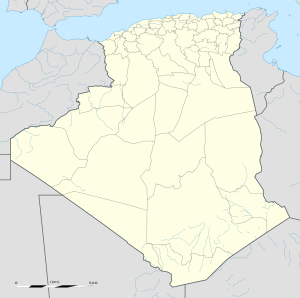
Summary
Bounoura (Arabic: بونورة, Berber: ⴰⵜ ⴱⵓⵏⵓⵔ, At-Bounour, البونور) is a town and commune in Ghardaïa Province, Algeria. According to the 2008 census it has a population of 35,405,[1] up from 27,775 in 1998,[2] with an annual growth rate of 2.5%.[1] It is effectively a suburb of the provincial capital Ghardaïa.
Bounoura
بونورة | |
|---|---|
Commune and town | |
 Bounoura ksar. | |
 Location of Bounoura commune within Ghardaïa Province | |
 Bounoura Location of Bounoura within Algeria | |
| Coordinates: 32°28′57″N 3°42′13″E / 32.48250°N 3.70361°E | |
| Country | |
| Province | Ghardaïa Province |
| District | Bounoura District |
| Elevation | 493 m (1,617 ft) |
| Population (2008)[1] | |
| • Total | 35,405 |
| Time zone | UTC+1 (CET) |
Bounoura is also the name of one of the ksars of the pentapolis of the M'zab valley, constituting the commune of Bounoura.[3]
Geography edit
Bounoura lies on the banks of the Wadi Mzab, an intermittent river in the M'zab valley, just downstream upstream of Ghardaïa. The area has been listed as a UNESCO World Heritage Site.[4]
Transportation edit
Bounoura is located on the N1 highway, part of the Trans-Sahara Highway, which leads north to Laghouat and south to El Goléa, In Salah and Tamanrasset.
Education edit
7.0% of the population has a tertiary education, and another 16.0% has completed secondary education.[5] The overall literacy rate is 86.3%, and is 95.3% among males (joint highest in the province) and 77.2% among females.[6]
Localities edit
In 1984, the commune of Bounoura is composed of five localities, including Beni Isguen ksar. [7] From the 1990s, new localities emerged to respond to the housing crisis. This is particularly the case of Tafilelt, Tinemmirine, Tawenza and Tinaâm attached to Bounoura, which were built according to the principles of ksourian architecture, and adapted to the proximity of the desert.[8][9]
- Bounoura historic ksar
- Beni Izguen from the new highschool and new C.E.M.
- Sidi Abbaz neighbourhood
- Bounoura palm grove
- Beni Isguen historic ksar
-
Bounoura ksar.
-
Great mosque of Bounoura.
-
Bounoura roundabout, monument for Moufdi Zakaria.
-
Beni Isguen ksar.
-
Beni Isguen ksar from the sky.
-
View of the new town Tafilelt.
-
View of the new town of Tinemmirine, from the new town of Tafilelt.
-
Tafilelt street.
-
Boulila tower, mosque and 4-fingered iduden, Beni Isguen ksar.
-
Beni Isguen ksar street.
-
Market place, Beni Isguen ksar.
References edit
- ^ a b c "Population: Ghardaïa Wilaya" (PDF) (in French). Office National des Statistiques Algérie. Archived from the original (PDF) on 16 May 2013. Retrieved 13 February 2013.
- ^ "Algeria Communes". Statoids. Retrieved 9 March 2013.
- ^ Côte, Marc (1996). Guide d'Algérie : paysages et patrimoine (in French). Média-Plus. p. 242. ISBN 9961-922-00-X.
- ^ "M'Zab Valley". UNESCO World Heritage Centre. Retrieved 13 February 2013.
- ^ "Structure relative de la population résidente des ménages ordinaires et collectifs âgée de 6 ans et plus selon le niveau d'instruction et la commune de résidence" (PDF) (in French). Office National des Statistiques Algérie. Archived from the original (PDF) on 16 May 2013. Retrieved 13 February 2013.
- ^ "Taux d'analphabétisme et taux d'alphabétisation de la population âgée de 15 ans et plus, selon le sexe et la commune de résidence " (PDF) (in French). Office National des Statistiques Algérie. Archived from the original (PDF) on 16 May 2013. Retrieved 13 February 2013.
- ^ "Décret n° 84-365, fixant la composition, la consistance et les limites territoriale des communes. Wilaya d'El Oued" (PDF) (in French). Journal officiel de la République Algérienne. 19 December 1984. p. 1578. Archived from the original (PDF) on 2011-06-05. Retrieved 2 March 2013.
- ^ "KSAR TAFILELT, UTOPIE ÉCO-CITOYENNE DEVENUE RÉALITÉ AUX PORTES DU SAHARA ALGÉRIEN". Capital. Retrieved 3 April 2018.
- ^ Gueliane, Nora (2019). Les nouveaux ksours de la vallée du M’Zab (1995-2016). De la permanence et des mutations de la solidarité sociale dans leurs réussites et leurs échecs (PhD thesis) (in French). École des hautes études en sciences sociales, Paris, France.


